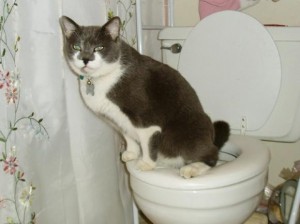 While it may seem like a dream come true to have your cat use the bathroom toilet instead of a messy litter box, there are many things that go in to the proper training. In addition to the training, there are a variety of pros and cons to being a pet owner of a cat who uses the toilet. The most obvious reason to want to teach your cat to use the toilet instead of a litter box is the now clean area where the litter box once sat. If you only have one toilet in your home, that could be a reason why you would want your kitty to have it’s own place to relieve himself, instead of your toilet.
While it may seem like a dream come true to have your cat use the bathroom toilet instead of a messy litter box, there are many things that go in to the proper training. In addition to the training, there are a variety of pros and cons to being a pet owner of a cat who uses the toilet. The most obvious reason to want to teach your cat to use the toilet instead of a litter box is the now clean area where the litter box once sat. If you only have one toilet in your home, that could be a reason why you would want your kitty to have it’s own place to relieve himself, instead of your toilet.
Advantages to Toilet Training a Cat
- The cost savings of not having to constantly buy litter and the supplies that go along with it can really add up over the course of a year, let alone the length of a cat’s life.
- Boxes or bags of litter, however you purchase them, can weigh up to 25 pounds or more. There will be no more lugging these heavy items home from the store and into your home.
- You will no longer need a specific place to store the litter box, trying to keep it as far away from your living area as possible. You will also no longer need a place to store the replacement litter, bags, scooper, and other supplies.
- You could actually reduce your energy consumption (although by very little) because you wouldn’t have to vacuum that particular area daily.
- Your cat will no longer track litter from its litter box to your couch, and you will no longer have the distinctive aroma of cat urine surrounding the area where the litter box is kept.
- Toilet training your cat will have about an 80% success rate, meaning that most cats should be trainable with the proper patience from pet owners.
- Toilets diminish the risk of humans contracting parasites or infectious diseases like toxoplasmosis, ringworm, or tapeworm from cat waste.
Disadvantages to Toilet Training a Cat
- Toilet training a cat is not an easy process. It is time consuming and as a pet owner, you must have considerable patience and an open mind.
- Cats instinctively bury their waste to hide it from predators, and litter fosters that instinct in a way that using the toilet does not, causing some cats to scrape the bowl, the tank or the wall next to the toilet.
- Cats enjoy their normal routine, so if they have been using a litter box for most of their life, changing to a toilet could cause them to become stressed and you could see an increase in accidents.
- There is nothing about the size or height that is normal to a cat. If, during the training process, your cat falls into the toilet, you can pretty much give up at that point, as they will no longer be open to anymore training.
- As a pet owner, you will need lots of patience to toilet train your cat. If you go too fast, your cat might find other places to go like your furniture, plants, rugs, or closets.
- A owner whose cat uses the litter box can be alerted to some health problems or issues by actually seeing the color or texture of the waste. With a toilet, you can’t monitor the cat’s health by seeing how it “comes out”.
- As a toilet-trained cat ages, it may have a hard time jumping up onto the toilet seat.
- A cat is likely to find another place to go rather than wait in line at a bathroom door, so having an second bathroom the cat can use will work out best.
Each cat owner will have to weigh the pros and cons to toilet training to determine if it is the right approach for you to take. One suggestion is to train the animal from the kitten stages to get the best results.






[…] your cat is toilet trained, cat litter is a necessity, but with all of the different kinds available, how do you decide which […]
[…] All Pet News: Toilet Training Your Cat: Pros and Cons […]
Comments are closed.